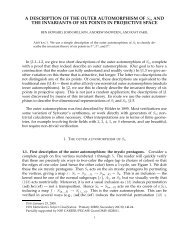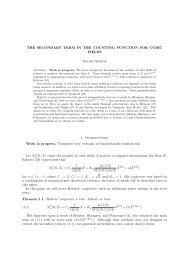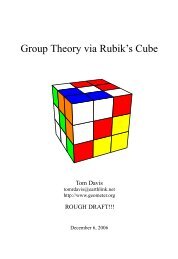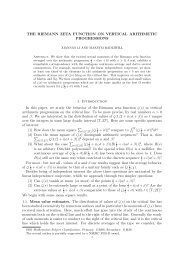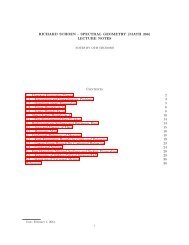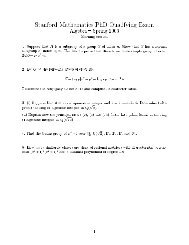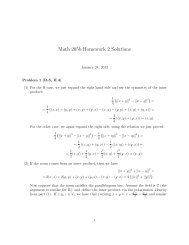Traveling Wave Solutions in a Reaction-Diffusion Model for Criminal ...
Traveling Wave Solutions in a Reaction-Diffusion Model for Criminal ...
Traveling Wave Solutions in a Reaction-Diffusion Model for Criminal ...
You also want an ePaper? Increase the reach of your titles
YUMPU automatically turns print PDFs into web optimized ePapers that Google loves.
Recall that g ′ (0) = 0 and so <strong>for</strong> the steady state (0, 0) the eigenvalues are<br />
It is useful to def<strong>in</strong>e the functional<br />
As k = − g(1)α<br />
c<br />
References<br />
λ1 = 1<br />
c , λ± = −c ± √ c2 + 4<br />
.<br />
2<br />
Q(λ, k) :=<br />
> 0 then we see that <strong>in</strong>deed λ > µ.<br />
<br />
λ − 1<br />
<br />
λ 2<br />
+ cλ − 1 − k. (60)<br />
c<br />
[1] Mohammed Al-Refai. Existence, uniqueness and bounds <strong>for</strong> a problem <strong>in</strong> combustion theory.<br />
J. Comput. Appl. Math., 167(2):255–269, June 2004.<br />
[2] H. Berestycki, F. Hamel, and R. Monneau. One-dimensional symmetry of bounded entire<br />
solutions of some elliptic equations, 2000.<br />
[3] H. Berestycki and J.-P. Nadal. Self-organised critical hot spots of crim<strong>in</strong>al activity. European<br />
Journal of Applied Mathematics, 21(Special Double Issue 4-5):371–399, 2010.<br />
[4] Henri Berestycki, Hiroshi Matano, and Franois Hamel. Bistable travel<strong>in</strong>g waves around an<br />
obstacle. Communications on Pure and Applied Mathematics, 62(6):729–788, 2009.<br />
[5] Victoria Booth and Thomas Erneux. Understand<strong>in</strong>g propagation failure as a slow capture<br />
near a limit po<strong>in</strong>t. SIAM Journal of Applied Mathematics, 55(5):1372–1389, 1995.<br />
[6] L.E. Cohen and M. Felson. Social change and crime rate trends: A rout<strong>in</strong>e activity approach.<br />
American sociological review, 44(4):588–608, 1979.<br />
[7] P. C. Fife and L. A. Peletier. Cl<strong>in</strong>es <strong>in</strong>duced by variable migration. In Biological growth<br />
and spread (Proc. Conf., Heidelberg, 1979), volume 38 of Lecture Notes <strong>in</strong> Biomath., pages<br />
276–278. Spr<strong>in</strong>ger, Berl<strong>in</strong>, 1980.<br />
[8] Paul C. Fife and J. B. McLeod. The approach of solutions of nonl<strong>in</strong>ear diffusion equations<br />
to travell<strong>in</strong>g front solutions. Arch. Ration. Mech. Anal., 65(4):335–361, 1977.<br />
[9] RA Fisher. The wave of advance of advantageous genes. Ann. Eugenics, 7:353–369, 1937.<br />
[10] D. Gilbarg and N. Trud<strong>in</strong>ger. Elliptic partial differential equations of second order. 1983.<br />
[11] Jong-Shenq Guo and Yoshihisa Morita. Entire solutions of reaction-diffusion equations and<br />
an application to discrete diffusive equations. Discrete Cont<strong>in</strong>. Dyn. Syst., 12(2):193–212,<br />
2005.<br />
[12] S. Johnson, Bowers K., and Hirschfield. New <strong>in</strong>sights <strong>in</strong>to the spatial and temporal distribution<br />
of repeat victimisation. Br. J. Crim<strong>in</strong>ology, 37:224–244, 1997.<br />
[13] James P. Keener and Timothy J. Lewis. <strong>Wave</strong>-block <strong>in</strong> excitable media due to regions of<br />
depressed excitability. SIAM Journal of Applied Mathematics, 61(1):293–316, 2000.<br />
[14] G. O. Mohler, M. B. Short, P. J. Brant<strong>in</strong>gham, F. P. Schoenberg, and G. E. Tita. Self-<br />
Excit<strong>in</strong>g Po<strong>in</strong>t Process <strong>Model</strong><strong>in</strong>g of Crime. Journal of the American Statistical Association,<br />
106(493):100–108, March 2011.<br />
28



